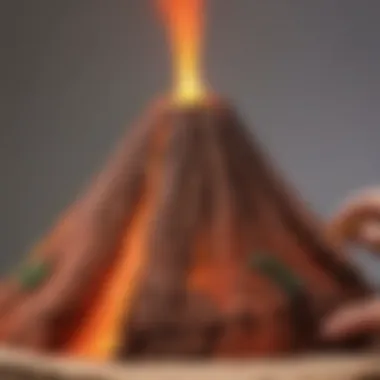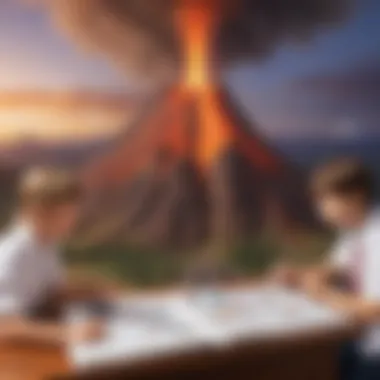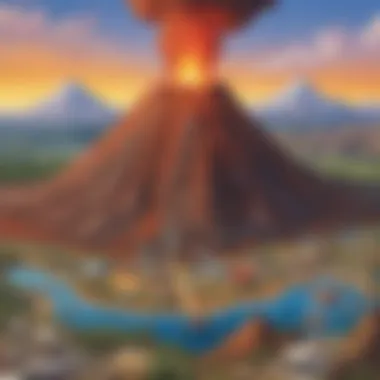Step-by-Step Guide on How to Make a Volcano Science Project


Science Fun Facts
Did you know that volcanoes can form in different ways, either through tectonic plate movements or hot spots in the Earth's mantle? The largest volcano in our solar system is actually located on Mars, named Olympus Mons, towering over 13 miles high! Volcanoes have been erupting for millions of years, shaping the landscape and providing a glimpse into the Earth's fiery core.
Discover the Wonders of Science
Embark on a journey through the wonders of science as we delve into the fascinating process of creating a volcano for a science project. By exploring various scientific concepts such as chemical reactions and geology, children and science enthusiasts alike will gain a deeper appreciation for the natural world. Watch educational videos and animations to witness the science behind volcanic eruptions come to life!
Science Quiz Time
Test your knowledge with interactive quizzes that challenge your understanding of volcanoes and the forces that drive their eruptions. Can you decipher between different types of volcanic rocks or identify the stages of a volcanic eruption? Engage in brain teasers and puzzles that make learning about volcanoes both fun and informative. Embrace gamification as a playful way to enhance your scientific knowledge!
Science Experiment Showcase
Dive into a hands-on experience with fun and engaging experiments that bring the excitement of volcanic eruptions right to your home. Follow step-by-step instructions to construct a realistic volcano model using simple household materials like baking soda and vinegar. Ensure safety by adhering to precautions like wearing protective gear and conducting the experiment in a well-ventilated area. This experiment showcases the thrilling fusion of science and creativity!
Introduction
Welcome to the exciting world of creating your very own volcano for a spectacular science project. This engaging process combines fun with learning, making it an ideal activity for children aged 6-12 and science enthusiasts alike. By following the detailed steps outlined in this guide, you will embark on a journey that not only entertains but also educates.
Overview of the Project
Why make a volcano
Delving into the reasoning behind constructing a volcano for your science project unveils a multitude of benefits. Making a volcano allows for a hands-on exploration of geological formations and natural disasters. Through this project, participants gain a deeper understanding of volcanoes and the science behind their eruptions. The unique feature of creating a volcano lies in its ability to merge scientific knowledge with creative expression, offering a holistic learning experience that is both engaging and informative.
Learning opportunities
The process of making a volcano opens doors to various learning opportunities. From understanding chemical reactions to exploring earth science concepts, this project offers a comprehensive educational experience. Participants can enhance their knowledge of geology, chemistry, and physics in a practical and interactive manner. By engaging in this project, learners not only grasp scientific principles but also develop critical thinking and problem-solving skills, making it a rewarding endeavor for both children and science enthusiasts.


Materials Needed
When embarking on the adventurous journey of creating a volcano for a science project, the first and foremost aspect to consider is gathering the essential materials required to bring this exciting project to life. The Materials Needed section plays a pivotal role in ensuring the successful execution of constructing a volcano that not only looks impressive but also offers a fascinating learning experience for children and science enthusiasts. By carefully selecting and preparing the necessary items, you set the stage for an interactive and educational exploration into the world of volcanic eruptions.
Basic Supplies
In the realm of Basic Supplies, several key elements stand out as integral components in the creation of a compelling volcano model. These items are fundamental in establishing the foundation and visual appeal of the volcano, making them indispensable in the crafting process.
Baking Soda
One of the cornerstone ingredients in this project is Baking Soda, a versatile substance known for its effervescent properties. Baking Soda serves a crucial role in the eruption simulation of the volcano, creating the foaming lava effect that captivates viewers. Its alkaline nature reacts with the acidic Vinegar, producing a visually striking volcanic eruption. The simplicity and effectiveness of Baking Soda make it a popular choice for this article, enabling a safe yet impressive demonstration of volcanic activity
Vinegar
Another vital component in the chemical reaction that mimics volcanic eruptions is Vinegar. As an acidic liquid, Vinegar complements the Baking Soda by triggering the reaction that generates the bubbling lava effect. Its acidic properties interact with the alkaline Baking Soda to simulate the eruption process realistically. Vinegar's availability, affordability, and non-toxic nature make it a practical and accessible choice for creating engaging volcanic eruptions.
Container for volcano base
Ensuring the stability and aesthetic appeal of the volcano structure is the Container for volcano base, a critical element in the construction process. This container acts as the foundation upon which the volcano model rests, providing a stable platform for building and displaying the eruption effects. The size and shape of the container influence the overall design of the volcano, offering flexibility in creating diverse landscapes and eruption scenarios. Selecting a suitable container enhances the visual impact of the volcano, making it a crucial consideration in crafting a captivating and realistic science project.
Creating the Volcano
In the fascinating world of volcano science projects, the creation of the volcano itself stands as a crucial element. Building the volcano structure serves as the centerpiece of the entire project, capturing attention and showcasing the eruption effects in a visually captivating manner. The process of constructing the volcano not only offers hands-on learning but also sharpens creativity and experimentation skills, making it an essential step in the journey of scientific exploration.
Building the Structure
Using modeling clay
Modeling clay, a versatile and moldable material, plays a pivotal role in crafting the volcano structure. Its pliable nature allows for intricate detailing and customization, enabling aspiring scientists to shape the volcano according to their creative vision. One key characteristic of using modeling clay is its ease of manipulation, making it an ideal choice for young learners looking to express their artistic flair. The unique feature of modeling clay lies in its ability to simulate realistic textures and landforms, adding a touch of authenticity to the volcano model. While modeling clay offers flexibility and artistic freedom, it may require time and patience to mold into desired shapes, a consideration worth noting for a comprehensive volcano-making experience.


Alternative methods
For those seeking diverse approaches to constructing a volcano, alternative methods present an exciting avenue for experimentation. These methods offer innovative ways to build the volcano structure, encouraging creativity and out-of-the-box thinking among young scientists. One key characteristic of alternative methods is their adaptability, allowing individuals to explore unconventional materials and techniques in crafting the volcano. The unique feature of alternative methods lies in their capacity to spark innovation and problem-solving skills, fostering a spirit of exploration and discovery. While alternative methods offer creativity and ingenuity, they may require careful planning and experimentation to ensure structural stability and visual appeal, a beneficial challenge for young minds eager to explore different construction techniques.
Adding Details
Painting the volcano
The art of painting the volcano brings the structure to life, adding vibrant colors and realistic textures to enhance its visual impact. Painting the volcano provides a creative outlet for personal expression, allowing individuals to customize the appearance and design of the model. One key characteristic of painting the volcano is its ability to transform a plain structure into a captivating work of art, engaging both visual and imaginative senses. The unique feature of painting lies in its power to evoke realism and depth, creating a dynamic visual effect that complements the eruption simulation. While painting adds aesthetic appeal and realism to the volcano, it requires precision and attention to detail to achieve desired visual outcomes, a rewarding endeavor for aspiring artists and scientists.
Adding landscaping
Integrating landscaping elements around the volcano adds depth and context to the overall presentation, creating a sense of environmental realism. Adding landscaping involves incorporating natural materials such as moss, small rocks, and miniature trees to mimic a natural volcano setting. One key characteristic of adding landscaping is its ability to contextualize the volcano within a realistic environment, enriching the storytelling aspect of the project. The unique feature of landscaping lies in its capacity to enhance the visual narrative of the volcano model, transporting viewers to a miniature volcanic landscape. While landscaping offers visual appeal and storytelling opportunities, it requires careful selection and placement of materials to maintain a harmonious and realistic portrayal, a creative challenge for young enthusiasts embracing the art of scientific diorama creation.
Eruption Effect
Creating a realistic eruption effect is a pivotal aspect of this science project. It captivates young minds and provides a hands-on understanding of volcanic activity. The eruption effect adds excitement and visual appeal to the project, making it an engaging and educational experience. By simulating a volcanic eruption, children can witness chemical reactions in action, fostering their curiosity and knowledge about geology and natural phenomena.
Simulating the Eruption
Chemical Reaction Demonstration
Exploring the chemical reaction demonstration component is essential for showcasing the eruptive process realistically. This step involves the careful mixing of baking soda and vinegar to produce carbon dioxide gas, mimicking volcanic eruptions. The fizzing and bubbling reaction not only imitates lava flows but also introduces children to fundamental chemistry principles in a fun and interactive manner. The chemical reaction demonstration highlights the role of acids and bases, promoting a deeper understanding of scientific concepts.
Enhancing the Effect
Enhancing the eruption effect amplifies the project's visual appeal and educational value. Various methods can enhance the effect, such as using food coloring to simulate lava colors or adding dish soap to create foaming eruptions. These enhancements allow children to customize their volcanic eruptions and observe how different variables influence the eruptive process. By experimenting with different enhancements, kids can grasp the complexity of volcanic activity while honing their creativity and critical thinking skills. Each enhancement choice offers unique insights into the science behind volcanic eruptions.
Safety Precautions


Safety precautions are a crucial aspect of any scientific project, including the creation of a volcano. Ensuring the safety of everyone involved, especially children aged 6-12, is paramount. By following safety guidelines, the risk of accidents or mishaps can be minimized, allowing participants to enjoy the project safely and responsibly. When engaging in hands-on activities like making a volcano, adult supervision is necessary to maintain a secure environment and provide assistance when needed. By focusing on safety precautions, participants can enhance their learning experience while staying protected from potential hazards during the project.
Adult Supervision
Importance of supervision
Adult supervision plays a pivotal role in ensuring the safety and well-being of children undertaking science projects like creating a volcano. Supervision helps in monitoring the activity, guiding the participants, and intervening in case of any emergencies. The presence of a responsible adult fosters a sense of security and promotes a positive learning atmosphere. Supervisors can offer valuable insights, answer questions, and facilitate the smooth progression of the project. Their vigilant oversight ensures that the activity remains educational, engaging, and accident-free.
Handling materials safely
Proper handling of materials is essential to prevent accidents and ensure a smooth scientific project experience. Teaching children how to handle ingredients like baking soda and vinegar safely enhances their understanding of chemical reactions and promotes responsible behavior. By following safety protocols, such as wearing protective gear and using tools correctly, participants can minimize risks and enjoy a hazard-free learning process. Emphasizing the importance of safe material handling cultivates a culture of attentiveness and care, essential for a successful volcano-making adventure.
Cleanup
Proper disposal of materials
Disposing of project materials correctly is a crucial step in maintaining a safe environment and teaching responsible waste management. Educating participants on the proper disposal methods for items like used containers and leftover materials promotes eco-conscious behavior and cleanliness. By incorporating proper disposal practices into the project, children learn the importance of environmental stewardship and sustainable practices. This not only reinforces the educational aspect of the volcano-making project but also instills habits that benefit the planet.
Maintaining a clean workspace
A tidy workspace is essential for ensuring the safety and efficiency of any hands-on project. Keeping the work area clean and organized reduces the risk of accidents, enhances productivity, and promotes a focused learning environment. Encouraging participants to tidy up after completing the project instills a sense of responsibility and respect for shared spaces. By maintaining a clean workspace, children not only ensure their safety during the activity but also cultivate valuable life skills related to organization and cleanliness.
Conclusion
In concluding the venture of constructing a volcano for a science project, it is imperative to acknowledge the multifaceted benefits and educational aspects encompassed within this engaging experiment. The culmination of this project not only symbolizes the culmination of creativity and scientific exploration but also serves as a medium through which young learners can grasp fundamental concepts of geology, chemistry, and experimentation. Through the process of constructing the volcano from basic materials to simulating eruption effects, children aged 6-12 are exposed to a hands-on learning experience that fosters curiosity and critical thinking skills. Moreover, the excitement of witnessing the eruption and comprehending the chemical reactions involved adds a layer of practicality to theoretical science concepts, making learning both enjoyable and applicable.
Reflecting on such an experience after the completion of the volcano project holds great value in reinforcing the concepts learned. It allows children to engage in self-assessment and establish a deeper connection with the scientific principles explored during the project. By reflecting on the steps taken, the challenges faced, and the outcomes observed, young learners cultivate a sense of accomplishment and a newfound appreciation for the scientific method. This reflection fosters a habit of inquiry and analysis that is crucial for their academic growth and future scientific endeavors, instilling in them a sense of wonder and curiosity towards the world around them.
Enjoying the Finished Product
Displaying the Volcano
When it comes to displaying the finished volcano, creativity and presentation play a significant role in enhancing the overall impact of the project. Choosing a prominent location within the house or classroom to showcase the volcano can serve as a visual representation of the child's effort and creativity. Placing the volcano on a sturdy table or platform not only ensures stability but also allows for better visibility, enabling viewers to admire the details and craftsmanship put into its construction. Adding elements like LED lights around the base of the volcano or using a rotating platform can create a dynamic visual effect, enhancing the eruption simulation experience and captivating the audience.
Reflecting on the Experience
The act of reflection post-volcano construction holds intrinsic value in the learning process, as it prompts children to introspect on their journey and draw meaningful conclusions from their experiences. Reflecting on the challenges encountered during the construction phase encourages problem-solving skills and resilience, teaching children that setbacks are opportunities for growth. Additionally, reflecting on the eruption effect and the scientific principles behind it reinforces the knowledge gained, solidifying their understanding of chemical reactions and geological processes. This introspection not only consolidates learning but also lays the foundation for future scientific explorations, nurturing a lifelong passion for discovery and innovation.







